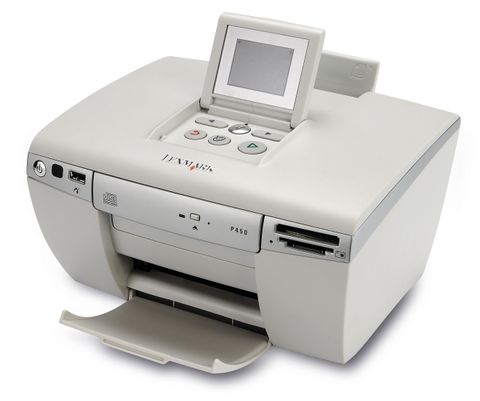TechRadar Verdict
The Lexmark P450 is simple to use, but unfortunately it tends to produce patchy results.
Pros
- +
CD writer
Colour LCD
Simple software
Cons
- -
Poor build quality
Poor prints
Lazy print time
Why you can trust TechRadar
The Lexmark P450 is distinguished from the rest of the group because it comes with a built-in CD writer, which Lexmark is parading as an industry first. That's true to a certain extent: it is the only printer at this price range with a CD writer, but we think the Sony DPP-SV88 was probably the first consumer printer with a CD, albeit at much higher price tag.
The CD fills up with images as you import them and burns when full, although you can burn earlier too if you like.
The software interface is probably the simplest to use of all the printers we tested. It's slow to respond, but hard to make a mistake with its big, child-like graphics. This will make the printer usable across a broad range of users who don't want to study a manual just to print a picture; they just want a machine with a toaster's level of operating ease that will make a snap materialise quickly.
The intuitiveness of the engineering stretches to a tidy, spring-loaded, photo-paper slot at the back of the machine that clamps the paper in place. The spring makes life easy, and is something the better machines in this test could have learnt from with their fiddly plastic slides. The ink cartridge is also incredibly easy to replace in two stages only.
However, there are some hefty drawbacks with the P450. The print time strolls in at a lazy 2 minutes and 44 seconds, and the results aren't that great. Plus, at 31p a shot (including the ink cost) it's a pricey print at that.
A textured mottling appeared on our test shots across a variety of papers, although not Lexmark's own, and there was also an odd colour range with too much yellow and orange.
Print quality is subjective so ask for a demo - but we think some problems are likely to persist, such as the mottling.
Tech.co.uk was the former name of TechRadar.com. Its staff were at the forefront of the digital publishing revolution, and spearheaded the move to bring consumer technology journalism to its natural home – online. Many of the current TechRadar staff started life a Tech.co.uk staff writer, covering everything from the emerging smartphone market to the evolving market of personal computers. Think of it as the building blocks of the TechRadar you love today.

The obscure little PC that wanted to be a big NAS — super compact Maiyunda M1 doesn't cost that much, offers up to 40TB SSD storage, runs Windows and has 4 Gigabit Ethernet ports

Image site Abload going offline reminds me of how much online content we've permanently lost

Gemini's next evolution could let you use the AI while you browse the internet
